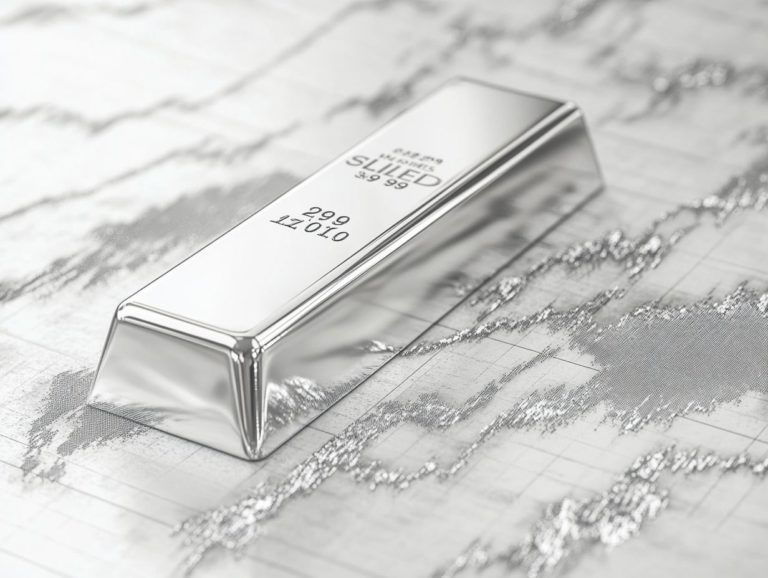The Evolution of Gold Investment Trends
Gold has captivated humanity for millennia, a timeless symbol of wealth, power, and beauty.
As you delve into the evolution of gold investment, you’ll uncover the factors that drive its enduring popularity and the diverse ways investors engage with this precious metal. From the tangible allure of physical gold to the modern intricacies of paper gold, you ll explore current trends and shifting demands in the market.
Looking ahead, you ll encounter future predictions and potential challenges in the ever-evolving landscape of gold investment, allowing you to navigate this fascinating arena with insight and foresight.
Contents
Key Takeaways:
- Gold has been a valuable asset for centuries, and its popularity as an investment continues to rise due to its stability and global demand.
- There are various types of gold investments, including physical and paper gold, each with its own benefits and risks.
- Current trends show a shift in demand for gold and investment strategies, focusing on digital platforms and socially responsible investing.
Brief History and Importance of Gold
Gold has symbolized wealth and prosperity for millennia, tracing back to ancient civilizations that cherished it not just for its beauty but for its rarity and intrinsic value. Throughout history, gold has stood as a crucial medium of exchange, a reliable store of value, and a safe haven during economic turbulence and geopolitical strife.
Historically, gold prices have held strong against inflation, making it an essential asset for investors looking to safeguard their wealth. From the early days of coinage to its contemporary role in investment portfolios, this precious metal has served as a trustworthy currency across various cultures, reflecting the economic climates of their eras.
In ancient Egypt, gold adorned tombs and symbolized the divine; in the Roman Empire, it was instrumental in trade and commerce, highlighting its universal allure.
Even today, amidst the ebb and flow of market conditions, many individuals view gold as a bulwark against inflation and currency devaluation, reinforcing its timeless significance. As global economic uncertainty looms, the value of gold remains a beacon for those seeking stability and reassurance in their investments.
The Rise of Gold Investment
In recent years, you might be amazed to see a significant surge in gold investment. Both Western investors and Asian funds increasingly acknowledge gold’s status as a safe haven amid economic uncertainty and market volatility.
This growing recognition drives global demand upward and profoundly influences the dynamics of gold prices.
Factors Contributing to Gold’s Popularity
Several factors contribute to gold’s enduring allure, especially its reputation as a hedge against inflation and a safe haven during geopolitical tensions. These elements significantly influence investor sentiment, driving up demand for this precious metal.
When prices rise and economic uncertainty looms, you may find yourself gravitating toward gold as a tangible asset that can preserve your purchasing power, prompting increased buying activity. Geopolitical events, whether conflicts or trade disputes, can stir volatility in financial markets, leading investors to seek refuge in gold to shield against potential losses in equities or currencies.
This shift in behavior isn t merely a matter of calculations; psychological factors are at play. The fear of losing capital or the uncertainty surrounding economic stability can incite a rush to acquire gold, impacting its price fluctuations and reinforcing its image as a reliable, albeit sometimes volatile, investment choice.
Types of Gold Investments
When exploring the various types of gold investments, you can choose between physical gold, such as bars and coins, and paper gold alternatives like gold ETFs (Exchange-Traded Funds) and OTC investment products.
Each choice presents its unique advantages and considerations, allowing you to tailor your investment strategy to your specific goals and preferences.
As you explore gold s potential, now is the perfect time to consider how it fits into your investment strategy!
Physical Gold vs. Paper Gold
Investors often find themselves at a crossroads, deciding between physical gold those tangible bars and coins and paper gold, represented by financial instruments like gold ETFs. Each option comes with its unique set of challenges and benefits, particularly regarding liquidity (how quickly you can sell your investment for cash) and safety.
Physical gold offers a reassuring sense of security thanks to its tangible nature. However, it demands careful thought about storage solutions and insurance to guard against theft or loss. The need for secure vaults can inflate your overall expenses. Additionally, managing these physical assets can be inconvenient.
In contrast, paper gold, like gold ETFs, grants you easier access to the market and enhanced liquidity, allowing you to buy and sell swiftly without the headaches of transportation or storage. It’s crucial to consider the risk of relying on another party and the lack of physical ownership that accompanies these financial instruments. This can challenge your peace of mind, especially during volatile market conditions.
Current Trends in Gold Investment
Current trends in gold investment showcase a landscape influenced by the ebb and flow of gold prices. Investors frequently engage in profit-taking, skillfully adjusting their strategies in response to global demand and the shifting dynamics of market conditions.
Shifts in Demand and Investment Strategies
The shifts in demand for gold have been shaped by changing investor sentiment, with Asian funds increasingly stepping into the ring to compete alongside Western investors. This shift is altering the global dynamics of gold pricing and investment strategies.
This transformation reflects broader economic conditions and diverse cultural attitudes toward wealth preservation across different markets. In Asia, a burgeoning middle class and political uncertainties around the world have sparked a notable increase in gold purchases. Meanwhile, European demand remains stable but cautious, leaning more toward alternative investments, including an interest in the evolution of platinum in investment markets.
As these regional dynamics continue to evolve, it’s crucial for you to adjust your investment strategies accordingly. Future approaches must consider not only the growing appetite for gold in Asia but also the influences of inflation (a way to protect your investment from losing value due to rising prices) and currency fluctuations that can drive or dampen demand across various markets. For insights on this evolving landscape, explore the future of precious metals.
The Future of Gold Investment
The future of your gold investment is exciting and full of potential challenges and opportunities! Influenced by challenges like inflation, shifting market conditions, and the unpredictable nature of the global economy, these factors can sway the gold market, so you need to stay informed.
Predictions and Potential Challenges
Predictions for the gold market suggest that it will likely maintain its reputation as an inflation hedge. However, you should be aware of potential challenges, such as shifting investor sentiment and the rise of alternative investments that could impact its standing.
As global economies evolve and technological advancements reshape investment landscapes, you might find that the allure of gold faces stiff competition from cryptocurrencies and other digital assets. To stay informed, it’s important to keep an eye on the future of gold, as geopolitical tensions and shifts in monetary policy will also play crucial roles in determining gold’s appeal.
Market analysts note that while some investors may gravitate towards these new avenues, the intrinsic value and historical significance of gold as a safe haven could present unique opportunities for long-term stability (how consistently valuable an investment remains over time).
Navigating this complex environment will require your keen insight into macroeconomic trends and a well-considered approach to your individual investment strategies.
Frequently Asked Questions
What is the meaning of ‘The Evolution of Gold Investment Trends’?
The Evolution of Gold Investment Trends refers to the changes and developments in the ways people invest in gold over time.
Why is gold considered a valuable investment?
Gold is considered a valuable investment because it is a tangible asset that retains its value over time, is easy to trade, and serves as a safe haven during times of economic uncertainty.
How has the trend of investing in gold changed over the years?
The trend of investing in gold has shifted from primarily physical ownership to more diverse methods, such as gold-backed ETFs, mining stocks, and digital gold.
What factors influence gold investment trends?
Gold investment trends shift based on several key factors. Global economies, political events, and new technologies all play a role.
Is investing in gold risky?
Investing in gold carries risks, like any investment. Yet, it remains a safer choice compared to stocks or cryptocurrencies.
How can I stay updated on gold investment trends?
Stay updated by following financial news and reading industry reports. Engaging with experts can also provide valuable insights.














